Born in East Germany six months before the end of World War II, I spent my toddler years in a West German refugee camp. My father reestablished his dental practice in 1948, but a brain abscess in his temporal lobe brought my family’s postwar recovery to an abrupt halt. We immigrated to America in 1957, landing in the growing southwest hub of Phoenix, Arizona. Not knowing a word of English, I learned to speak the language by watching The Mickey Mouse Club and local children’s programming on television.
|
| This is the only baby picture of me known to exist. When it was taken, thousands of refugees were already pushing overladen carts through the snow, desperate to stay ahead of the advancing Red Army. |
 |
| An aerial view of Lockstedter Lager, the refugee camp where I spent the first four years of my life. |
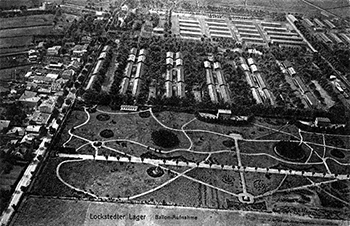 |
| I am shown here, on the right, with my mother, Gisela, and my brothers, Gunther on the far left, and Rüdiger in the middle. This photograph must have been taken before we left the refugee camp. On the back are written the words, “Ohne Vati (Without Dad).” |
 |
| Bad Hersfeld, as it looked when my family moved there from the refugee camp in 1948. The town’s need for a dentist was our family’s ticket to recovery, and my father’s dental practice thrived until his brain abscess led to its failure and our subsequent immigration. |
 |
| My father took this photograph of my mother and her three small “men” in Bodensee (Lake Constance) in the south of Germany in the early fifties. It was the one vacation we took together as a family before my father fell ill. For a few short years we were riding the crest of Germany’s postwar recovery. I am the boy in the middle. |
 |
| In April of 1957, my family made the voyage to America aboard the MS General W. C. Langfitt, a troop transporter put to service under the Refugee Act of 1955 that facilitated immigration for displaced people. We caught passage on one of the last boatloads of Eastern European refugees to immigrate under the Refugee Program. |
 |
| Shortly after our arrival in Phoenix in April of 1957, we posed for a classic Arizona photograph. The first time I saw a Saguaro cactus from the window of the train that carried us into the “Valley of the Sun,” I thought it was a "tall man.” I am third from the right. |
 |
| My family made the Arizona Republic in June, 1957. I am standing, second from the right, next to my father. The article broadcast our plight, but no leads developed for a suitable job for my father. |
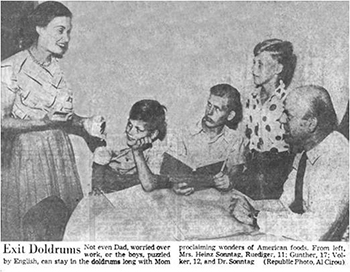 |
| My mother stands outside our third home in Phoenix in the early 1960s. It was an improvement over the second house that we called “the shed.” |
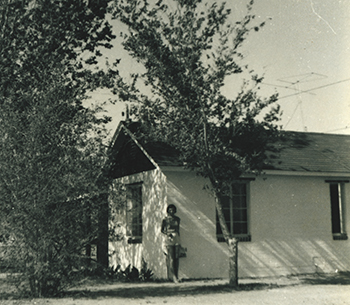 |
| Here I am with my parents, Heinz and Gisela Sonntag, in the late 1950s. My father had been the son of an ENT doctor in Berlin, and had established a thriving dental practice during the postwar recovery. My mother had been the daughter of the mayor of her hometown and had assisted Dad with his practice. In Arizona, they struggled to find work and keep our family together. |
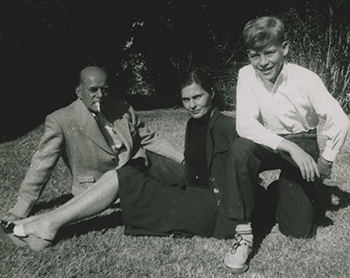 |
Working on a chicken farm owned by a man named Mr. Reynolds during my high school years, I got a real-life example of the man’s-gotta-do-what-a-man’s-gotta-do philosophy. Then I worked my way through Arizona State University flipping burgers at a local Jack in the Box hamburger restaurant. I attended the University of Arizona School of Medicine, serving as President of the first graduating class in 1971 and completing my internship there. In 1972, I moved to Tufts-New England Medical Center Hospital in Boston, MA, where I trained as one of the first residents under Bennett M. Stein, M.D., Professor and Chairman, Department of Neurosurgery. I completed my residency in 1977.
|
| Jack in the Box was a step up from working on the chicken farm. I started there my senior year in high school and stayed with the company all through my undergraduate years at ASU. |
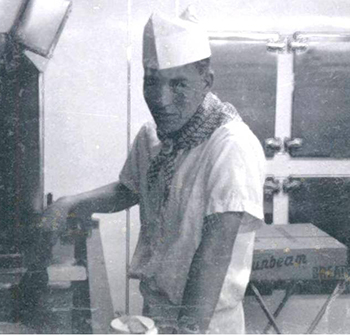 |
| At ASU, I was thrilled to finally play soccer on an organized team in the United States. The popularity of the sport skyrocketed during my time at ASU and U of A. I am the blond middle guy in the front row. |
 |
| I felt positive about my future in medicine when I was chosen as the first recipient of the Fred. G. Holmes Memorial Scholarship at ASU in 1967. My first semester in medical school at U of A was still a rude awakening, though. |
 |
| As a med student at U of A’s brand new medical school, ca. 1970. I was probably thinking about the debt I was piling up and wondering if I had what it took to get through med school. |
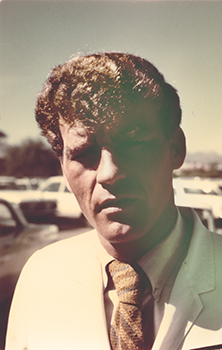 |
| The University of Arizona Medical School as it looked when I graduated in 1971. |
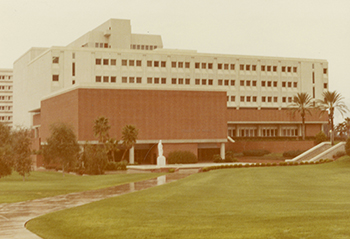 |
| Here I am, third from the left, as a young resident at Tufts New England Medical Center in Boston in the early 1970s, at a time when 120 hour work week was the norm for young doctors. |
.jpg) |
| On a visit to see my ailing father in Arizona in 1974, I crossed paths with a nursing student I had fallen in love with two years earlier, just as I was preparing to leave for my residency in Boston. We were married five days later. It was the best move I ever made. |
 |
After staying less than a year in my first position post-residency at Saint Elizabeth’s in Youngstown, Ohio, my wife Lynne and I returned with our infant daughter, Alissa, to Arizona in 1979. It took me four years to build up a practice, and it was a proud moment when I became a founding associate of Barrow Neurosurgical Associates at Barrow Neurological Institute in 1983. BNI was the vehicle by which I also found my vocation as a teacher. I started the Spine Fellowship there in 1988, and assumed the role of Residency Program Director in 1995. In a career spanning thirty years, I performed surgery on thousands of patients and was fortunate to make significant contributions to the understanding of spinal disorders. I have also co-edited seven major books, made more than 800 presentations around the world, and written more than 98 textbook chapters and 460 papers.
|
| The first “calling card” for the new group formed in 1983. |
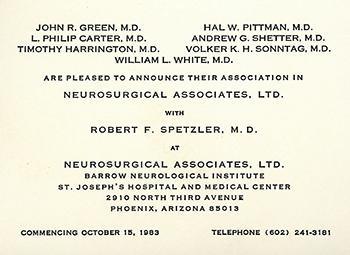 |
| I was nearly forty years old when I took this seat in the front row, far left, circa 1983, the year Barrow Neurosurgical Associates was formed. Dr. John Green, founder of Barrow Neurological Institute, is to the right of me. At the far right, is Robert Spetzler, M.D., Chairman of BNI. |
 |
| One of my first widely covered cases, in 1989, was an eight-year-old boy whose skull had been disconnected from his upper cervical spine when he was struck by a truck on his way to school. Given the severity of the injury, along with a host of other internal and external injuries, my colleagues and I gave him a five percent chance of survival. Days after the successful surgery, the press dubbed him the “Miracle Boy.” He went on to make a complete recovery. |
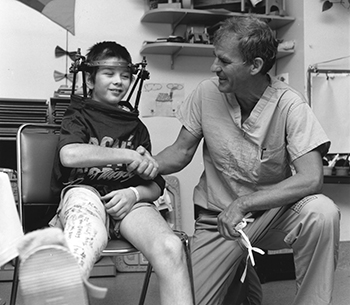 |
| Soccer has been a passion of mine since I was a young boy, and coaching my two sons in the sport over a decade and a half was a great bonding experience. It was also an essential part of the balance of life. Here I am with my elder son, Chris, in the mid 1990s. |
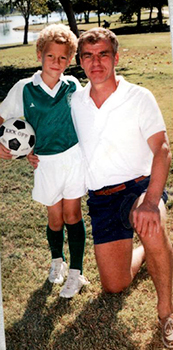 |
| And here I am with my younger son, Stephen, at the World Cup in South Africa in 2010. The importance of time together with family is something I tried to impart to the residents I mentored for thirty-five years. |
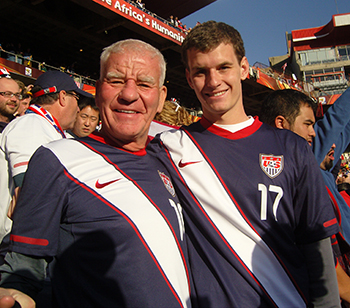 |
| I began to be known as “Chiefy” in the 1990s. I put a lot of stock in integrity and a solid work ethic, but have never discounted the value of a healthy sense of humor. |
 |
| The fall of the Berlin Wall was a deeply personal event for me. After it was breached in 1989, my brother Gunther and I passed through to East Germany at the Brandenburg Gate. I returned several times over the next few years as the Wall gradually came down. In 1990, I chipped off a little chunk of history to carry home. |
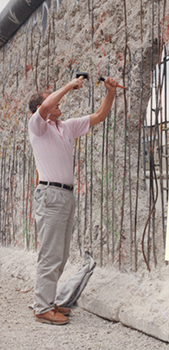 |
| Robert Spetzler and I flank a young doctor at Paradise Valley Country Club at a ceremony for residents in the mid 1990s. Meeting and working with Robert has been one of the most surprising and gratifying events in my life. |
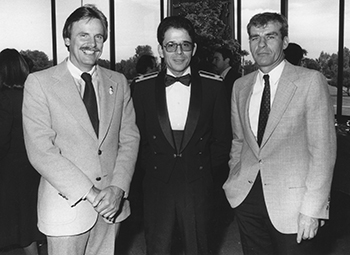 |
| Here Robert and I are in recent days. Few things are as gratifying as the kind of working relationship we developed, and the good-humored rivalry. |
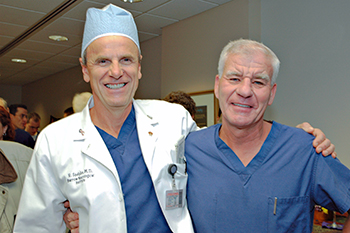 |
| Here I am, with my wife Lynne and son Stephen, after the Diamondbacks won the World Series in 2001. I was proud to be neurosurgeon to the team, and thrilled to see my son get to hold that trophy. |
 |
During my career, I have had the honor of being recognized as one of the Best Doctors in America. My proudest moment came in 2002, when I was named the Honored Guest of the Congress of Neurological Surgeons, the highest honor paid to a neurosurgeon by his peers.
When not speaking at neurological conferences in far-flung spots, I can be found spending time with my family or traveling. I would like to be remembered as “somebody who attempts to strike the perfect balance, with passion for work (especially research and the residency program), passion for family and passion for life.”
I retired from practicing neurosurgery in January 2010, but I remain at the Barrow Neurological Institute as Vice Chairman Emeritus. In 2012, Barrow Neurological Institute completed construction on the Sonntag Academic Pavilion to honor my contributions to neurosurgery and especially spinal neurosurgery. The educational pavilion is state-of-the-art with electronic audio and video equipment to accommodate lectures, live surgery demonstrations, and educational conferences.
|
|